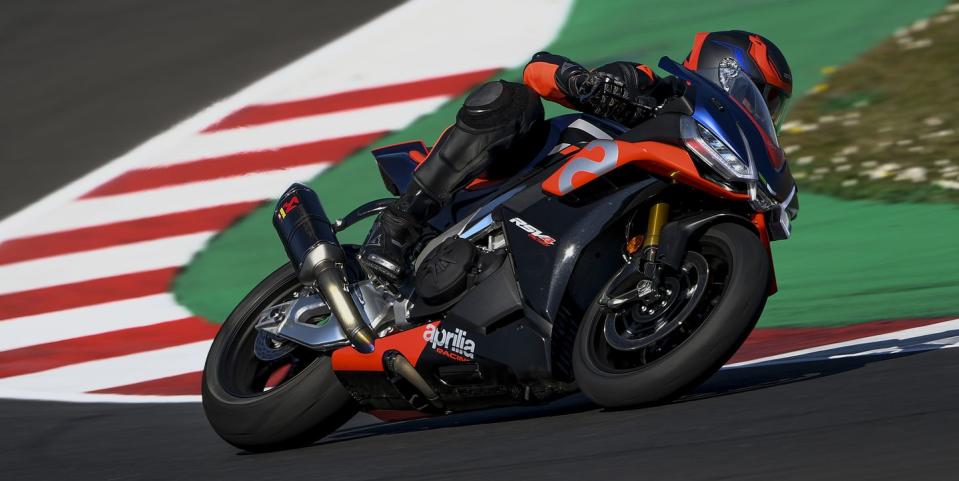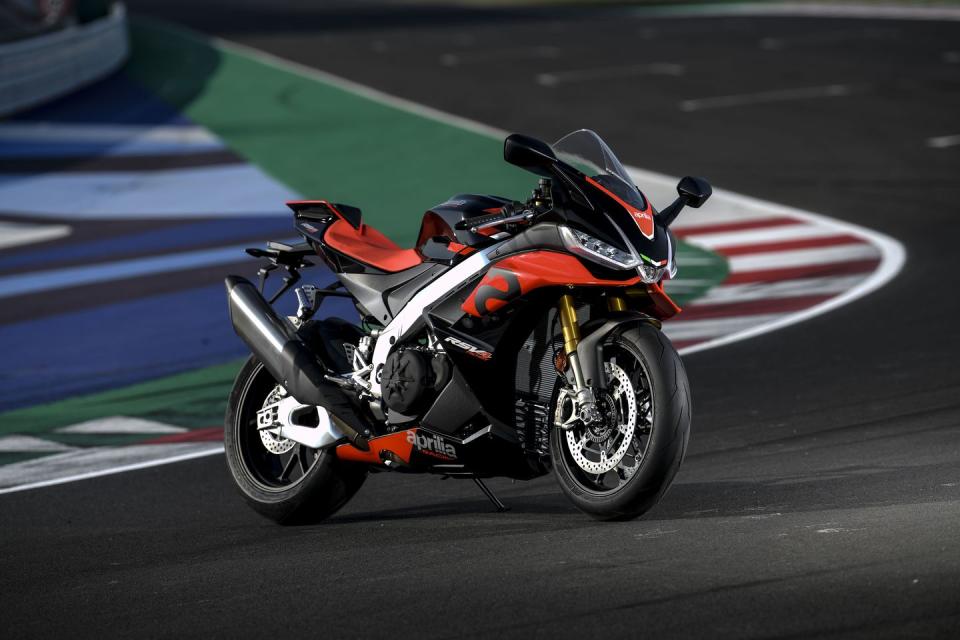Aprilia RSV4 1100 Factory Is a Missile for the Street—and Track

The 2022 Aprilia RSV4 1100 Factory is a 217-hp street-legal production motorcycle weighing in at just 445 pounds.
The weight-to-power ratio of 2.1:1 bests the likes of a Ferrari F8 Tributo—by more than double.
It also delivers a lot more power per dollar: With a sticker price of $25,999, it costs less than a tenth of what the Ferrari goes for.
Since Autoweek is a car publication and all, consider this: Ferrari’s high-falutin’ 710-hp twin-turbo F8 Tributo has a weight-to-power ratio of 4.5:1 lb/hp. Pretty impressive. It also carries an MSRP of $283,950 and requires a racetrack to exploit, both legally and dynamically. Now meet the 2022 Aprilia RSV4 1100 Factory, a $25,999 street-legal production motorcycle with 217 normally aspirated horses and tipping in at 445 lb for a 2.1:1 weight-to-power ratio. That’s over twice the punch for 9 percent of the Prancing Horse’s price. The Aprilia likewise needs a racetrack to fully utilize—but a much bigger one than Laguna Seca Raceway in California, where we recently found ourselves guiding this two-wheeled cruise missile.
Measuring a slinky 2.2 miles around, Laguna Seca is among the most challenging road courses in America, or anywhere. With relentless elevation changes and variously cambered turns—including the famous 5 ½-story drop that is the Corkscrew—it requires fighter-pilot level critical thinking, care and precision to get right. Some courage helps too.
Suited up and sweating in tight-fitting racing leathers, boots, helmet and gloves, I swung a leg over the RSV4, dropped into the solo seat, switched on the ignition and used the 5-inch LCD display and switchgear to configure the electronic settings afforded this top-of-the-line model. Ride-by-wire throttle mapping, launch control, traction control, wheelie control, engine braking, front and rear ABS, rear-wheel anti-lift, adjustable semi-active suspension…the list goes on. After selecting track settings compatible with the machine’s DOT tires, tapping the starter button brought a baritone V4 growl.

From here on, it was like hugging a grizzly on Adderall; vibrating and growling, you’re the machine and it is you. Then rap the throttle—bereft of much flywheel, the revs spike instantly, along with the noise. There is no firewall, no 4-point racing harness, no door beams, no window net nor fire bottle. Just you aboard a big, bad bottle-rocket, released on your own recognizance to conduct your own private Walter Mitty Challenge. Clicking the 6-speed gearbox lever down for first, we burbled towards pit out. This should be interesting.
Aside from sharing general racetrack practices and enjoying Isaac Newton’s blessed g-forces, riding the Aprilia and driving a car here are profoundly dissimilar. One reason is that the bike is just 29 inches wide at the mirror-tips, spreading the line choices enormously. Another is motorcycling’s hugely participatory experience. Astride the machine, your knees clench the fuel tank and your legs and feet tuck against the frame. Hunched forward to reach the handlebars, your wrists, arms and shoulders bear the weight of your upper body. “Let’s get physical!” sang Olivia Newton-John, though perhaps not about this bike.
A modest lap to build tire temperatures and then on it. The Aprilia’s traction and wheelie control software are so efficient, that while banking through hairpin Turn 11, eyeing the front straight, and pulling the trigger, the rear end hardly wiggled and the front didn’t pitch skyward—just a brief wheelie as the revs surged. A quick-shifter helps the six-speed dog-box work nearly instantly up as well as down, including rev-matching on downshifts. Literally, once on track, you needn’t touch the clutch.
The powerband gets serious above 9000 rpm and peaks at 13,000 rpm, letting the Aprilia reportedly accelerate from 0-60 mph in 2.7 seconds and then surpass 189 mph. But that couldn’t happen this time. “There are absolutely no straightaways anywhere,” Al Holbert said of Laguna Seca in 1982. “Even the fast parts of the racecourse have squiggles in them!”

 Yahoo Autos
Yahoo Autos 